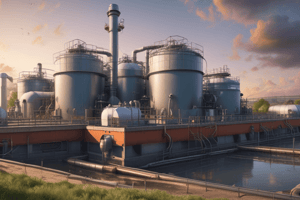Podcast
Questions and Answers
What is a key challenge in improving sewage canals according to the text?
What is a key challenge in improving sewage canals according to the text?
- Rebranding them as waterways
- Not involving local communities
- Renaming them as negative structures
- Showcasing their importance (correct)
Which strategy involves organizing events to raise awareness about sewage canals?
Which strategy involves organizing events to raise awareness about sewage canals?
- Tangible Improvements
- Citizenship Engagement
- Refraiming Public Perspectives (correct)
- Involving Local Communities
What type of councils do volunteers participate in to help improve sewage canals?
What type of councils do volunteers participate in to help improve sewage canals?
- Environmental councils
- Housing councils
- Sewage councils
- Watershed councils (correct)
Which approach involves transforming how people view sewage canals by promoting sustainable living practices?
Which approach involves transforming how people view sewage canals by promoting sustainable living practices?
What is one way to engage with communities according to the text?
What is one way to engage with communities according to the text?
Which strategy involves showcasing ways in which sewage systems benefit society?
Which strategy involves showcasing ways in which sewage systems benefit society?
What is one way to involve residents in sewage system improvement projects?
What is one way to involve residents in sewage system improvement projects?
What tangible improvements can be made to sewage systems?
What tangible improvements can be made to sewage systems?
Why is community involvement important in sewage system projects?
Why is community involvement important in sewage system projects?
How can sewage canal improvement programs be strengthened?
How can sewage canal improvement programs be strengthened?
Why is integrating green infrastructure elements into sewage systems beneficial?
Why is integrating green infrastructure elements into sewage systems beneficial?
What does the example from Kampala, Uganda demonstrate?
What does the example from Kampala, Uganda demonstrate?
Flashcards are hidden until you start studying
Study Notes
Enhancing Sewage Canals through Perception and Citizenship Strategies
Sewage canals have historically been perceived as unsightly and problematic, yet they play a critical role in managing wastewater from cities around the world. To improve these vital infrastructures, it's essential to implement both technical solutions and innovative approaches to address perceptions and engage with communities. Here, we explore three key aspects of this endeavor — perception strategies, citizenship engagement, and tangible improvements to sewage canals.
Reframing Public Perspectives
The concept of reframing public perspectives is crucial when dealing with issues like sewage canals. One of the primary challenges lies in changing negative associations into positive ones by highlighting their importance and showcasing ways in which these systems benefit society. This can involve rebranding efforts such as renaming them as waterways, organizing events to raise awareness, and capitalizing on opportunities presented by National Clean Water Week or World Water Day campaigns. By promoting sustainable living practices and fostering community involvement, stakeholders aim to transform how people view sewage canals.
Involving Local Communities
Citizen participation plays a pivotal role in improving sewage canals. Through initiatives like watershed councils, volunteers help maintain environmental quality while also raising local awareness. These groups encourage residents to report pollution incidents, participate in cleanups, and act as ambassadors within their neighborhoods. Moreover, involving communities in decision-making processes promotes ownership, facilitating the implementation of more inclusive projects aligned with local needs and concerns.
An example of successful citizen engagement comes from Kampala, Uganda, where local residents were instrumental in preserving wetlands alongside sewer lines. As a result, wildlife habitats flourished while flood risks decreased due to enhanced natural drainage. This case demonstrates how cooperation between municipal authorities and civic organizations leads to effective outcomes beyond mere sewer upgrades.
Tangible Improvements to Sewage Systems
While perception shifts and community involvement undoubtedly strengthen sewage canal improvement programs, tangible improvements remain fundamental. Adopting state-of-the-art technologies is imperative; for instance, installing smart sensors, drones for inspection purposes, and energy recovery devices improves sewage treatment efficiency. Additionally, integrating green infrastructure elements helps remove pollutants before they reach sewers and prevents flooding during heavy rainfall. Examples range from vegetated walls and constructed wetlands to green roofs and stormwater planters — all contributing to improved system performance and aesthetically pleasing environments.
In conclusion, enhancing our relationship with sewage canals involves addressing challenges related to public perception, engaging local communities, and implementing advanced technology innovations. A multi-faceted approach allows us to build resilient systems that support healthy urban lifestyles while simultaneously reducing ecological harm and protecting valuable resources.
Studying That Suits You
Use AI to generate personalized quizzes and flashcards to suit your learning preferences.




